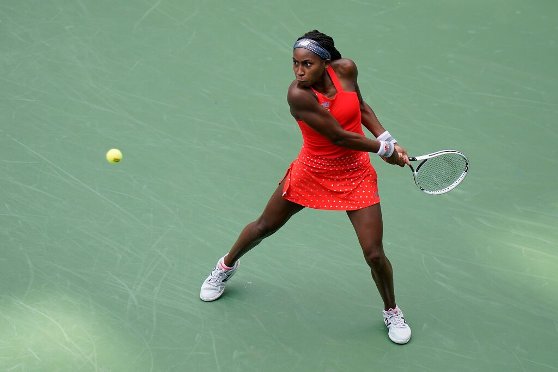Coco Gauff, last year’s crowd favourite, loses in the first round without one
By Christopher Clarey
NEW YORK —With no roar from the fans, all that was left on Monday (Aug 31) for Coco Gauff was the roar of the planes as they passed over the all-but-empty Louis Armstrong Stadium.
Down below was a strange scene: Gauff and Anastasija Sevastova, an opponent nearly twice her age, locked in an edgy and erratic duel surrounded by stands covered in big blue tarps.
A year ago, Gauff, an American teenager who has embraced the big occasion in her short career, rode a wave of support in Armstrong Stadium to reach the third round of the US Open. But against Sevastova, she failed to recapture the same form and was defeated in the first round, 6-3, 5-7, 6-4, amid the silence.
“I just got on tour a little over a year ago, so I still have a lot to learn and a long ways to go,” said Gauff.
That was abundantly clear on Monday. Gauff double faulted 13 times and had her serve broken seven times against Sevastova, the No. 31 seed from Latvia. Though Gauff avoided double faults in the final game of the match, she was unable to avoid a series of errors off her less reliable forehand wing.
“I hope everybody gives Coco plenty of time,” said Tracy Austin, one of tennis’ most remarkable wunderkinds, who reached No. 1 and won two US Opens in her teens. “I think it would be kind, and it would be the right thing to do. Take it from someone who has been through it and who all of the sudden was thrust into I don’t want to call it chaos but an intense spotlight.”
Sevastova can be a challenge for a player of any age. She is a crafty 30-year-old veteran who is adept at mixing spins and tactics and has an often-devastating backhand drop shot. Though she has struggled in 2020, both before and after the extended tour hiatus because of the coronavirus pandemic, she has had her best results at the U.S. Open, reaching the quarterfinals in 2016 and 2017 and the semi-finals in 2018.
She battled herself mentally on Monday, surrendering a winning position with a 4-2 lead in the second set with a series of errors as she frequently cast withering glances at Ronald Schmidt, her coach and boyfriend.
Gauff had internal tussles of her own, putting a hand to her forehead repeatedly after double faults and looking imploringly toward her father Corey and mother Candi, who were sitting court-side with masks covering most of their faces. But both players stabilized in the final set with the final game providing the only break of serve.
“I wish I would play like this when I was 16 years old,” Sevastova said admiringly of Gauff. “Great player. Nothing more to say. I think she maybe started a bit slower than me, but she was getting better as the match went on. That’s so important I think in tennis.”
Gauff, who reached the fourth round of Wimbledon in her first Grand Slam tournament in 2019, started this season auspiciously, upsetting Naomi Osaka in the fourth round of the Australian Open in January before losing in the quarterfinals in three sets to American compatriot Sofia Kenin, the eventual champion.
She spent the forced break at home in Delray Beach, Florida, practicing with her father Corey and her co-coach Jean-Christophe Faurel. She then played a strong comeback tournament at the Top Seed Open in Lexington, Kentucky, defeating two seeded players — Aryna Sabalenka and Ons Jabeur — in taut three-set tussles before losing in the semi-finals to Jennifer Brady, another eventual champion.
But Gauff was unable to produce consistent tennis in the two-tournament bubble in New York, losing 6-1, 6-3 in the first round of the Western & Southern Open to Maria Sakkari, the No. 13 seed, and then losing to Sevastova in their first meeting. Though it is tempting to attribute Monday’s defeat to Sevastova’s unusual style, Gauff did manage to prevail in Lexington against Jabeur, a player with a similarly varied game and flair for the exotic shot.
It seems premature to speculate about a sophomore slump for Gauff. But Gauff’s serve and forehand have been less than dependable in recent weeks with double faults and errors piling up. Gauff has struggled to find consistency with her service toss and repeatedly caught her toss on Monday, particularly in the first two sets.
“It’s surprising that Coco’s serve was not retooled more during pause of play,” said Pam Shriver, a former US Open singles finalist who is now an ESPN analyst, in a post on Twitter. “Toss too high. Toss too erratic. Pause on take-back too long. Not enough weight transfer.”
Sevastova often played to Gauff’s forehand on important points and did so again during the final game, when Gauff made four unforced forehand errors, including the final stroke of the match, which landed in the net on Sevastova’s fourth match point.
Until Monday, Sevastova had not won a singles match in a regular tour event this season, going 0-7. But her only other victory in 2020 was a big one: coming against Serena Williams in Latvia’s 3-2 defeat to the United States in a Fed Cup qualifying round match. That was Williams’ first singles loss in Fed Cup, which, it should be pointed out, she has played sparingly through the decades.
But when in form, Sevastova’s unusual game can bewitch the opposition, and she deployed her arsenal of pace changes and drop shots effectively against Gauff, one of the fastest players on tour even at her young age.
“She’s moving so well, it’s tough to finish the point,” Sevastova said. “She hits amazing backhand. Forehand for sure could be better. Still, it’s uncomfortable to play her.”
-New York Times


